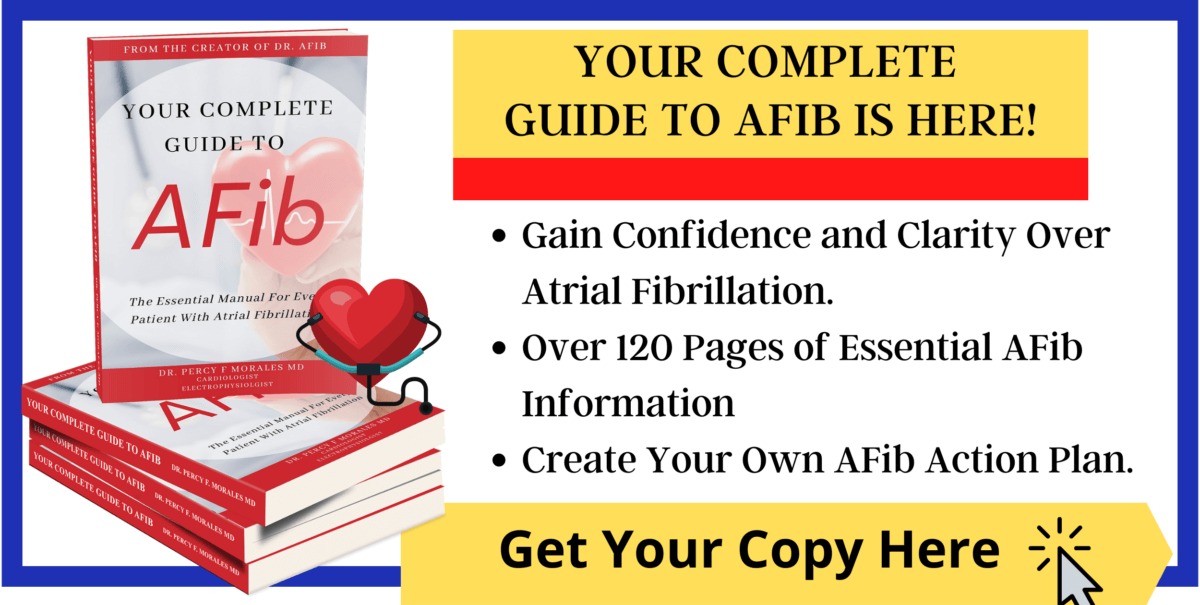Today I will discuss chronic AFib and give tips for people who are living with chronic atrial fibrillation. So, what does it mean to have chronic atrial fibrillation? Chronic atrial fibrillation means that someone is in atrial fibrillation all the time, and they likely have been in atrial fibrillation consistently for several years. Sometimes chronic atrial fibrillation is also called long-standing persistent atrial fibrillation. In addition, in these settings, there is no intention to not be in atrial fibrillation, meaning that either you or your doctor have decided that you are not a candidate for rhythm control strategies, and the only plan is to keep you in atrial fibrillation and control atrial fibrillation.
How Long Can You Live With Chronic Atrial Fibrillation?
When it comes to living with atrial fibrillation long-term, there’s no clear data that says that your life expectancy is less if you have chronic atrial fibrillation versus somebody that does not, or compared someone who has AFib that comes and goes, also called paroxysmal atrial fibrillation. If you would like to read more about paroxysmal atrial fibrillation, check out my article on paroxysmal atrial fibrillation here. However, there are several key points that need to be monitored when somebody is in longstanding chronic or persistent atrial fibrillation.
Chronic AFib Treatment Tips
What are some of the main tips that I can give to someone who is in chronic atrial fibrillation to maximize heart function and reduce risks, complications, or stroke from chronic atrial fibrillation? I usually tell my patients there are three important points to monitor when someone has chronic AFib.
Chronic Atrial Fibrillation Rate Control
Number one tip would be controlling your heart rate. When I have patients who are in chronic atrial fibrillation, even if everything looks like it’s going fine and your heart rate appears to be well controlled, I usually do routinely a 24-hour heart monitor at least every one to two years just to confirm that everything is well controlled with your heart rate.
An elevated heart rate is what makes people feel more short of breath or increases risk for things like congestive heart failure. Atrial fibrillation tends to make a heart rate go faster. So, when I do a 24-hour heart monitor, I’m looking to see how is the heart rate controlled over an entirety of 24 hours, not just a moment in time when someone is visiting a doctor’s office, and in the 24-hour heart monitor it will give me a good average heart rate throughout the entire day. It will say your average heart rate is 80 beats per minute or 110 beats per minute on average, for example.
In general, I try to shoot for a average heart rate of less than 100 beats per minute. There are some studies that came out in the past that show slightly higher averages of about 110 are also safe as long as there’s no evidence for shortness of breath or congestive heart failure. But in general for my patients, I try to keep the heart rate under 100 beats per minute.
Chronic AFib And Stroke Prevention
The number two important feature is stroke risk reduction. Being in chronic atrial fibrillation, it’s very important to have a discussion about your risk of stroke. Risk of stroke is not necessarily determined by whether you have chronic or paroxysmal atrial fibrillation. The best way these days to assess risk of stroke is with a stroke risk calculator such as the CHADSVasc risk score. People with a CHADSVasc risk score of over two for men or three for women are typically recommended to take stronger blood-thinning medications called anti-coagulation to reduce risk of stroke. If you would like to read more about assessment of stroke risk, check out my article on risk of stroke here.
However, it’s always optional to take blood-thinning medication even if you are at a lower risk of stroke. I tend to be on the conservative side when someone is in chronic atrial fibrillation, I tend to prefer to place my patients on anti-coagulation medication if they are in chronic atrial fibrillation, even if they have a lower CHADSVasc risk score. Part of that is because risk of stroke increases as people get older, so the stroke risk will get higher as people age, especially if they’re in AFib all the time.
In addition, there has been newer evidence over the last several years showing that long-term atrial fibrillation can also increase risk for dementia as well. So, patients may not get a clear-cut stroke, but they may have small, tiny little blood clots that don’t necessarily cause a stroke, but over the period of years or even decades can increase risk for dementia. The main medications that can reduce that risk for dementia appear to be blood-thinning medication. As a result, I tend to be pretty conservative on people who are chronic atrial fibrillation to recommend blood-thinning medication.
Now, for those who are unable to tolerate blood-thinning medication, there may be alternative options including procedures such as a Watchman procedure. If you’d like to know more about a Watchman procedure, please check out my article on Watchman procedure here.
Chronic Atrial Fibrillation and Risk for Congestive Heart Failure
The third thing that is important when it comes to living with chronic atrial fibrillation is to routinely assess your heart function and to reduce your risk for heart failure. This means evaluate the overall strength of your heart muscle, which typically involves getting an echocardiogram. An echocardiogram typically looks at the overall function of the heart, and also assesses the valvular function of your heart, to make sure everything appears to be stable. When patients of mine are in chronic atrial fibrillation, I routinely check an echocardiogram every one to two years just to make sure that the heart function is staying overall stable, and to prevent heart failure.
When someone first has chronic atrial fibrillation or persistent atrial fibrillation diagnosed, I typically will check an echocardiogram at the beginning of diagnosis as well as six months later just to make sure that the heart function remains stable. I’ve had several patients that when they first develop persistent atrial fibrillation that heart function may be perfectly normal and stable, but then several months later of being in atrial fibrillation the heart function begins to decline and they develop congestive heart failure. In those cases, if the heart function is declining, it is very important to either get very strict control of atrial fibrillation or to discuss rhythm control options to get someone out of atrial fibrillation. Routinely checking your heart function with an echocardiogram is an important test. Frequently a decrease in heart function can be detected before you develop symptoms by routine testing. The earlier a decrease in heart function is discovered, the more likely the heart function will recover with treatment.
In Conclusion:
These are my main tips to people who are living with longstanding persistent atrial fibrillation or chronic atrial fibrillation, but always discuss with your doctor what is the right treatment and tests for you.
The Best Atrial Fibrillation Book
Your Complete Guide To AFib: The Essential Manual For Every Patient With Atrial Fibrillation
$15.95 (as of May 29, 2025 06:52 GMT -06:00 - More infoProduct prices and availability are accurate as of the date/time indicated and are subject to change. Any price and availability information displayed on [relevant Amazon Site(s), as applicable] at the time of purchase will apply to the purchase of this product.) The A to Z guide on everything you need to know about atrial fibrillation. Written by AFib expert Dr. Percy Morales MD. Over 120 pages of essential information on medications, procedures, and lifestyles modifications for AFib. Easy to read for every patient.
Shop AFib Products on Amazon
KardiaMobile 6-Lead Personal EKG Monitor – Six Views of The Heart – Detects AFib and Irregular Arrhythmias – Instant Results in 30 Seconds – Works with Most Smartphones - FSA/HSA Eligible
13% Off
KardiaMobile 1-Lead Personal EKG Monitor – Record EKGs at Home – Detects AFib and Irregular Arrhythmias – Instant Results in 30 Seconds – Easy to Use – Works with Most Smartphones - FSA/HSA Eligible
$79.00 (as of May 29, 2025 05:52 GMT -06:00 - More infoProduct prices and availability are accurate as of the date/time indicated and are subject to change. Any price and availability information displayed on [relevant Amazon Site(s), as applicable] at the time of purchase will apply to the purchase of this product.)
Apple Watch Series 9 [GPS 41mm] Smartwatch with Storm Blue Aluminum Case with Silver Sport Band M/L. Fitness Tracker, Blood Oxygen & ECG Apps, Always-On Retina Display
(as of May 29, 2025 06:52 GMT -06:00 - More infoProduct prices and availability are accurate as of the date/time indicated and are subject to change. Any price and availability information displayed on [relevant Amazon Site(s), as applicable] at the time of purchase will apply to the purchase of this product.)
Fitbit Sense 2 Advanced Health and Fitness Smartwatch with Tools to Manage Stress and Sleep, ECG App, SpO2, 24/7 Heart Rate and GPS, Shadow Grey/Graphite, One Size (S & L Bands Included)

OMRON 2-in-1 Upper Arm Blood Pressure Monitor & 1-Lead EKG Monitor - Clinically Validated Blood Pressure Arm Cuff & Machine - Use OMRON Connect App
18% Off
Samsung Galaxy Watch 6 44mm Bluetooth Smartwatch, Fitness Tracker, Personalized HR Zones, Advanced Sleep Coaching, Heart Monitor, BIA Sensor, Health Wellness Insights, Big Screen, US Version, Graphite
12% Off
Natural Rhythm Triple Calm Magnesium 150 mg - 120 Capsules – Magnesium Complex Compound Supplement with Magnesium Glycinate, Malate, and Taurate. Calming Blend for Promoting Rest and Relaxation.
$20.77 ($0.17 / Count) (as of May 29, 2025 05:52 GMT -06:00 - More infoProduct prices and availability are accurate as of the date/time indicated and are subject to change. Any price and availability information displayed on [relevant Amazon Site(s), as applicable] at the time of purchase will apply to the purchase of this product.)
Pure Encapsulations Magnesium (Glycinate) - Supplement to Support Stress Relief, Sleep, Heart Health, Nerves, Muscles, and Metabolism* - with Magnesium Glycinate - 180 Capsules
$44.60 ($0.25 / Count) (as of May 29, 2025 06:52 GMT -06:00 - More infoProduct prices and availability are accurate as of the date/time indicated and are subject to change. Any price and availability information displayed on [relevant Amazon Site(s), as applicable] at the time of purchase will apply to the purchase of this product.)















![Apple Watch Series 9 [GPS 41mm] Smartwatch with Storm Blue Aluminum Case with Silver Sport Band M/L. Fitness Tracker, Blood Oxygen & ECG Apps, Always-On Retina Display #1](https://m.media-amazon.com/images/I/311xwtp4mFL._SL100_.jpg)
![Apple Watch Series 9 [GPS 41mm] Smartwatch with Storm Blue Aluminum Case with Silver Sport Band M/L. Fitness Tracker, Blood Oxygen & ECG Apps, Always-On Retina Display #2](https://m.media-amazon.com/images/I/41j+8AaUGsL._SL100_.jpg)
![Apple Watch Series 9 [GPS 41mm] Smartwatch with Storm Blue Aluminum Case with Silver Sport Band M/L. Fitness Tracker, Blood Oxygen & ECG Apps, Always-On Retina Display #3](https://m.media-amazon.com/images/I/41jIyxZitnL._SL100_.jpg)
![Apple Watch Series 9 [GPS 41mm] Smartwatch with Storm Blue Aluminum Case with Silver Sport Band M/L. Fitness Tracker, Blood Oxygen & ECG Apps, Always-On Retina Display #4](https://m.media-amazon.com/images/I/41IpNJERjCL._SL100_.jpg)
![Apple Watch Series 9 [GPS 41mm] Smartwatch with Storm Blue Aluminum Case with Silver Sport Band M/L. Fitness Tracker, Blood Oxygen & ECG Apps, Always-On Retina Display #5](https://m.media-amazon.com/images/I/31o17yhfYpL._SL100_.jpg)






































